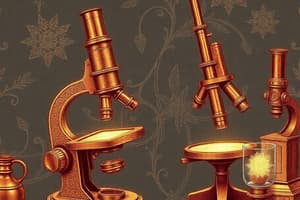Podcast
Questions and Answers
What does the arm of a microscope do?
What does the arm of a microscope do?
Supports the tube and connects it to the base
What is the eyepiece used for?
What is the eyepiece used for?
It is the lens at the top that you look through.
What is the function of the base of a microscope?
What is the function of the base of a microscope?
Used for support
What does the body tube connect?
What does the body tube connect?
What is the coarse adjustment used for?
What is the coarse adjustment used for?
What is the purpose of the fine adjustment?
What is the purpose of the fine adjustment?
How many objective lenses are generally found on a microscope?
How many objective lenses are generally found on a microscope?
What does the light/mirror do in a microscope?
What does the light/mirror do in a microscope?
What is the stage of a microscope used for?
What is the stage of a microscope used for?
What holds the slides in place on a microscope?
What holds the slides in place on a microscope?
What is the revolving nosepiece?
What is the revolving nosepiece?
The human eye cannot perceive objects less than:
The human eye cannot perceive objects less than:
The objective lenses of the compound light microscope are attached to the:
The objective lenses of the compound light microscope are attached to the:
Which objective lens provides the least total magnification?
Which objective lens provides the least total magnification?
The __________ increases or decreases the light intensity of the compound light microscope.
The __________ increases or decreases the light intensity of the compound light microscope.
Basic lens cleaning is accomplished using:
Basic lens cleaning is accomplished using:
When preparing a wet mount specimen for viewing, it should be covered with _______.
When preparing a wet mount specimen for viewing, it should be covered with _______.
The total magnification achieved using a 10x objective lens with a 10x eyepiece lens is 20x.
The total magnification achieved using a 10x objective lens with a 10x eyepiece lens is 20x.
A stereomicroscope is a good option to use for viewing rather large, opaque specimens.
A stereomicroscope is a good option to use for viewing rather large, opaque specimens.
Flashcards
Microscope Arm
Microscope Arm
Supports the body tube and connects it to the base, providing structural integrity.
Microscope Eyepiece
Microscope Eyepiece
The lens through which you view the specimen, often magnifying 10X or 15X.
Microscope Base
Microscope Base
Provides a stable foundation and support for the entire instrument.
Body Tube
Body Tube
Signup and view all the flashcards
Coarse Adjustment
Coarse Adjustment
Signup and view all the flashcards
Fine Adjustment
Fine Adjustment
Signup and view all the flashcards
Objective Lens
Objective Lens
Signup and view all the flashcards
Light Source
Light Source
Signup and view all the flashcards
Microscope Stage
Microscope Stage
Signup and view all the flashcards
Stage Clip
Stage Clip
Signup and view all the flashcards
Revolving Nosepiece
Revolving Nosepiece
Signup and view all the flashcards
Limit of Human Vision
Limit of Human Vision
Signup and view all the flashcards
Scanning Objective Lens
Scanning Objective Lens
Signup and view all the flashcards
Iris Diaphragm
Iris Diaphragm
Signup and view all the flashcards
Lens Paper
Lens Paper
Signup and view all the flashcards
Coverslip
Coverslip
Signup and view all the flashcards
Total Magnification
Total Magnification
Signup and view all the flashcards
Stereomicroscopes
Stereomicroscopes
Signup and view all the flashcards
Microscope Arm
Microscope Arm
Signup and view all the flashcards
Study Notes
Microscope Components
- Arm: Supports the body tube and links it with the base.
- Eyepiece: Contains the lens through which the viewer observes, typically offering 10X or 15X magnification.
- Base: Provides stability and support for the entire microscope.
- Body Tube: Connects the eyepiece to the objective lenses, facilitating light passage.
Focusing Mechanisms
- Coarse Adjustment: Used for initial focusing with low power lenses; allows significant tube movement.
- Fine Adjustment: Enables precise focusing for high power lenses by making smaller adjustments.
Objective Lenses
- Objective Lens: Usually three or four lenses available, with magnifications of 10X, 40X, and 100X. Color-coded by length, where the shortest offers the lowest power.
Light Source
- Light/Mirror: Provides illumination for viewing specimens; can be either a steady electrical light source (110 volts) or a mirror reflecting external light.
Stage and Slide Holding
- Stage: The flat surface to place slides, often equipped with clips or a mechanical system for slide movement.
- Stage Clip: Keeps slides securely in place during observation.
Revolving Mechanism
- Revolving Nosepiece: Holds multiple objective lenses, enabling quick changes between them for varying levels of magnification.
Microscope Specs and Features
- Objects smaller than 0.1 millimeter cannot be perceived by the human eye.
- Objective lenses attach to the rotating nosepiece, enabling easy switching.
- The scanning objective lens provides the least total magnification.
- Light intensity is adjusted with the iris diaphragm.
- Basic cleaning of lenses should be done using lens paper.
Wet Mount Preparation
- Wet mount specimens must be covered with a coverslip for optimal viewing.
Magnification Facts
- Total magnification is obtained by multiplying the eyepiece and objective lens powers; the 10X objective with a 10X eyepiece provides 100X, not 20X.
- Stereomicroscopes are suitable for viewing larger, opaque specimens effectively.
Studying That Suits You
Use AI to generate personalized quizzes and flashcards to suit your learning preferences.




